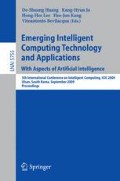Abstract
The morphological associative memories (MAM) have many attractive advantages. However, they can not give a guarantee that morphological hetero-associative memories are perfect, even if input patterns are perfect. In addition, the problem with the associative memory matrixes W XY and M XY is that W XY is incapable of handling dilative noise while M XY is incapable of effectively handling erosive noise. In this paper, the new methods of MAM, + W XY and + M XY are proposed. The certain qualifications that make + W XY and + M XY be perfect memories are analyzed and proved. As far as the hetero-associative memories are concerned, although + W XY and + M XY are not perfect, they are complements to original W XY and M XY . + W XY is capable of handling dilative noise while + M XY is capable of effectively handling erosive noise. Therefore they can be put together with original W XY and M XY to learn from others’ strong points to offset ones’ own weakness and to make the effect of hetero-associative memories and pattern recognition better. The calculation results demonstrate that both + W XY and + M XY are effectual.
Access this chapter
Tax calculation will be finalised at checkout
Purchases are for personal use only
Preview
Unable to display preview. Download preview PDF.
References
Davidson, J.L., Ritter, G.X.: A theory of morphological neural networks. In: Digital Optidal Computing II, vol. 1215, pp. 378–388 (1990)
Ritter, G.X., Sussner, P.: An introduction to morphological neural networks. In: Proc 13th Int. Conf. Pattern Recognition, Vienna, Austria, pp. 709–717 (1996)
Ritter, G.X., Sussner, P., Diaz-de-Leon, J.L.: Morphological Associative Memories. IEEE Transactions on Neural Networks 9(2), 281–292 (1998)
Chen, S.C., Liu, W.L.: Complex Morphological Associative Memories and Their Performance Analysis. Journal of Software (in Chinese) 13(3), 453–459 (2002)
Wang, M., Wang, S.T., Wu, X.J.: Initial Results on Fuzzy Morphological Associative Memories. Acta Electronica Sinica (in Chinese) 31(5), 690–693 (2003)
Wang, M., Chen, S.C.: Enhanced FMAM Based on Empirical Kernel Map. IEEE Transactions on Neural Networks 16(3), 557–564 (2005)
Wu, X.S., Wang, S.T.: Bidirectional fuzzy morphological associative memory and its robust analysis for random noise. Pattern Recognition and Artificial Intelligence (in Chinese) 18, 257–262 (2005)
Wu, X.S., Wang, S.T.: Fuzzy morphological associative memories and their application in storing and recalling cell images. Journal of Image and Graphics (in Chinese) 11(10), 1450–1455 (2006)
Sussner, P., Valle, M.E.: Gray-scale Morphological Associative Memories. IEEE Transactions on Neural Networks 17(3), 559–570 (2006)
Sussner, P., Valle, M.E.: Implicative Fuzzy Associative Memories. IEEE Transactions on Fuzzy Systems 14(6), 793–807 (2006)
Valle, M.E., Sussner, P.: A general framework for fuzzy morphological associative memories. Fuzzy Sets and Systems 159(7), 747–768 (2008)
Feng, N.Q., Qiu, Y.H., Wang, F., et al.: A Unified Framework of Morphological Associative Memories. In: Huang, D.S., Li, K. (eds.) Intelligent Control and Automation. Lecture Notes in Control and Information Sciences, vol. 344, pp. 1–11. Springer, Heidelberg (2006)
Author information
Authors and Affiliations
Editor information
Editors and Affiliations
Rights and permissions
Copyright information
© 2009 Springer-Verlag Berlin Heidelberg
About this paper
Cite this paper
Feng, N., Cao, X., Li, S., Ao, L., Wang, S. (2009). A New Method of Morphological Associative Memories. In: Huang, DS., Jo, KH., Lee, HH., Kang, HJ., Bevilacqua, V. (eds) Emerging Intelligent Computing Technology and Applications. With Aspects of Artificial Intelligence. ICIC 2009. Lecture Notes in Computer Science(), vol 5755. Springer, Berlin, Heidelberg. https://doi.org/10.1007/978-3-642-04020-7_43
Download citation
DOI: https://doi.org/10.1007/978-3-642-04020-7_43
Publisher Name: Springer, Berlin, Heidelberg
Print ISBN: 978-3-642-04019-1
Online ISBN: 978-3-642-04020-7
eBook Packages: Computer ScienceComputer Science (R0)

